|
Cicada Killer Wasp, Sand Hornet, Sphecius speciosus
|
The Cicada Killer Wasp, sometimes called Sand Hornet, or Sphecius speciosus in Latin, is an extra large wasp, the biggest in the eastern central states. It is common throughout the Midwestern and Southern states. They are common in July as they dig large holes for nests or burrows. These excavations are created by the female wasp and used to store large cicadas, sometimes called "locusts," as food for their young. In the Midwest, prey is often the Dog Day Cicada or Harvestfly, Tibicen pruinosa. Adult Cicada Killers feed on flower nectar. It is only the larvae that actually consume cicadas.
In the latter half of July, when the sound of the cicada fills the air, the Cicada Killer is often seen flying around deciduous trees from which the songs emanate. They disappear in the branches, and many times the cicada's song turns to an abrupt screech of horror as the wasp lances it with a paralyzing sting. |
 female cicada killer burrowing
female cicada killer burrowing
|
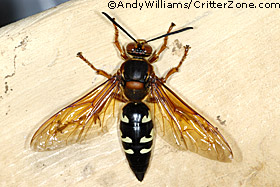 cicada killer wasp, Sphecius speciosus
cicada killer wasp, Sphecius speciosus
|
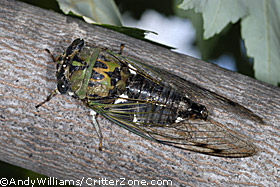 cicada, dog day harvestfly, Tibicen pruinosa
cicada, dog day harvestfly, Tibicen pruinosa
|
| The cicada goes into a comatose condition from which it never recovers. In this initial struggle, both the wasp and its victim often fall to the ground. The Cicada Killer immediately begins the laborious task of hauling its victim back up the tree while straddling it with its long legs. Cicadas are generally larger than their hunters, so getting one to an optimal launch pad high in the tree can take the wasp a good deal of time and energy. The Cicada Killer uses the tree to fly down to its burrow, which may be some distance away. |
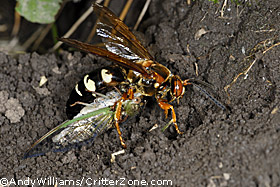 cicada killer wasp with cicada
cicada killer wasp with cicada
|
 cicada killer wasp stinging cicada
cicada killer wasp stinging cicada
|
| Well-drained areas with sparse vegetation, full sun, and dry, sandy or clay-like soil are the preferred habitat for Cicada Killer burrows. The burrow itself consists of a gently sloping entrance extending for about six inches, then typically turning at right angles and continuing for an additional six or eight inches and ending in a globular cell about one and one-half inches in diameter. Frequently a good number of branches leave the main burrow at about the same point with each terminating in a round cell. Females remove dirt from their burrows with the aid of spurred legs. They can be seen exiting the tunnel backwards with a mound of dirt preceding them. |
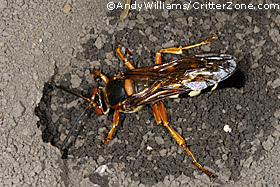 cicada killer wasp digging burrow
cicada killer wasp digging burrow
|
 cicada killer flying with cicada
cicada killer flying with cicada
|
| In August, each of the cells is stuffed with one or two cicadas. In cells that contain two cicadas, wasp larva turn out to be larger in size and female, while the smaller male larva generally get one cicada. Female Cicada Killer wasps decide which burrow will contain a male or female as unfertilized eggs turn into males, and the eggs they fertilize with stored sperm become females. |
| The white, elongated egg of the wasp is laid under one of the cicada's middle legs. When it hatches in two or three days, the larva sticks out its head and begins to draw nourishment from between the segments of its victim. The maggot feeds entirely from the outside and attains full size in roughly a week's time. Over a period of about two days, the larva spins a white, silken cocoon. The term “silken” may be a bit misleading since the fiber is mixed with quite a bit of dirt. When completed, the cocoon has about a dozen curious, pore-like openings in its side. Larvae remain in their cocoons underground throughout the winter, protected from the blizzards of winter. Not long after the larva transforms to pupa, the adult gnaws its way out of the cocoon and on up the burrow to the surface of the ground. Thus it accomplishes its life cycle in a full year. |
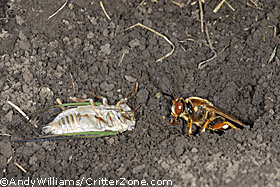 cicada killer dragging cicada
cicada killer dragging cicada
|
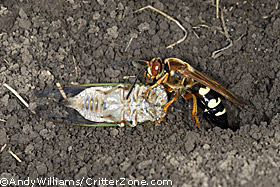 cicada killer dragging cicada
cicada killer dragging cicada
|
While the Cicada Killer is a fearsome looking wasp, if left alone, unharrassed, they have no reason to sting a human. The males might buzz around a person exhibiting territorial behavior, but they can't sting. The stinging females are preoccupied with finding cicadas for their young. This photographer spent several days seated directly in front of a large cooperative burrow. Cicada Killers buzzed in and out of their burrows, sometimes flying within inches of my head. As with most animals, being calm and leaving them to their lives will avert most problems. I've not been stung by one, but if you are, be sure to take proper care. As with any stinging insect, some people may have an allergic reaction and need medical attention.
Andy Williams / CritterZone.com |
The cicada killer wasp, and cicada pictures on this page are available for commercial stock photography license. All text and photos that appear on this webpage are copyrighted and may not be copied or used in any way without permission from CritterZone.
CritterZone does not specifically endorse our advertisers, or their methods. We cannot control the ads that run on our articles. CritterZone advocates humane and respectful treatment of all creatures.
Save this page:

|
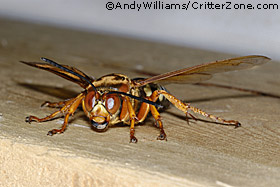 cicada killer wasp, Sphecius speciosus
cicada killer wasp, Sphecius speciosus
|